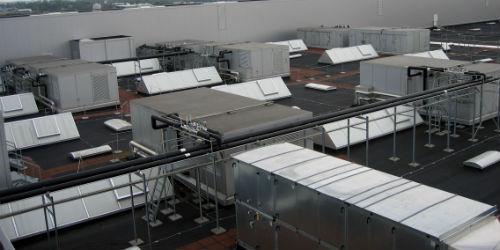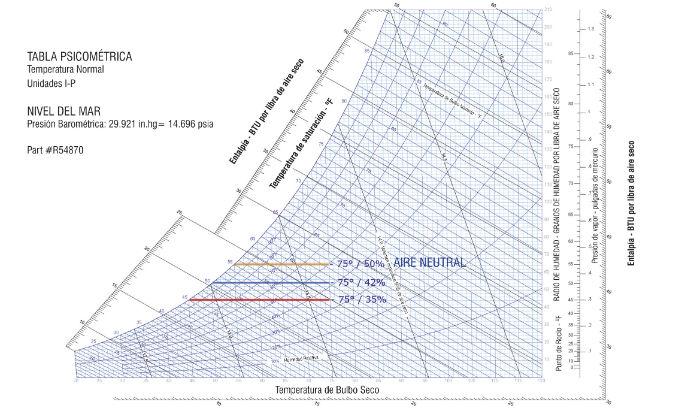A complete analysis to determine the best supply temperature in an air conditioning system.
complete analysis to determine the best supply temperature in an air conditioning system.
by Alfredo Sotolongo*
The most economical energy to produce is the one that is saved!
In this issue I would like to refer to an article published in the technical journal Engineered Systems in January 1999, entitled "WHY 55⁰F?" (Why 55⁰F?). The author is Eng. David E. Knebel, who at the time was the engineering and sales manager of Aaon, Inc.
Eng. Knebel refers to the fact that 55⁰F is frequently used as the air supply temperature in comfort applications. That's because it's become a habit to use 55⁰F and if it works, don't change it. He indicates that after 100 years of evolution of the air conditioning industry, it is time to objectively analyze air conditioning applications to determine the best supply temperature in relation to the following concepts:
- Initial System Cost – This includes the cost of all system components, from chillers to air diffusers.
- Indoor Air Quality – Among other things, pollution caused by chemicals, humidity and temperature that can affect the health of occupants.
- Thermal comfort – This refers to how occupants react to temperature, humidity, air movement, etc...
- Energy consumption – Today, when the cost of electrical energy is constantly increasing, it contributes to the total energy consumed by the air conditioning system.
Therefore, the value of the air temperature coming out of the coil 55⁰F or less, will considerably influence the volume of air to be supplied. This can reduce the initial cost, a more efficient system and the best indoor air quality. Achieving comfort that satisfies occupants and in commercial applications, improves productivity.

Many colleagues especially in 100% outdoor air applications for comfort air conditioning systems, where they must deliver the ventilation air in neutral air conditions, consider that to reach 75⁰F of dry bulb and 50% relative humidity it is best to discharge the air from the coil at 55⁰F. This is because when applying sensitive heat, in the psychometric table the horizontal line brings the air directly to the neutral air condition.
However, Eng. Knebel explains that when analyzing the four concepts above, it can be concluded that when the air leaves the coil between 45⁰F and 50⁰F the volume of air is reduced. By reheating the air and bringing it up to 75⁰F of dry bulb adding sensitive heat, lower relative humidity of 50% is achieved. Which is a benefit.
Regardless of the outdoor air conditions, even if they are places with high enthalpy, air conditioning systems are always optimized when the air is discharged at temperatures below 50⁰F.
In an example in the article, cities such as San Luis and Miami are compared, with different weather conditions and it is concluded that in both cases there are considerable reductions:
- The size of air handlers, filters, coil area are reduced by 7.5%.
- The internal area of the ducts is reduced by 29%.
- The diameter of the fan is reduced by 10%.
- Relative humidity is reduced by 10%.
- Energy consumption is reduced by 14.5% in St. Louis and by 5.3% in Miami.
Therefore, when the temperature of the supply air is reduced, it is evident that the following happens:
- The volume of air to be supplied is reduced, maintaining the same sensitive capacity.
- For the same area of the cooling coil, the loading speed is reduced.
- The evaporator temperature is going to be lower for the same cooling coil.
- The relative humidity of the conditioned area is going to be lower.
- The latent heat from the outside air will increase due to the lower humidity in the conditioned area and the total capacity will increase.
- The power of the compressor will increase to produce the lowest saturation temperature in suction.
- For the duct system, the power of the fan motor is proportional to the air flow hub.
It would be interesting in future designs to try to determine the optimal temperature for the supply air that represents the savings in initial and operating cost exposed above. If you were interested, I would be honored to participate with you to contribute to achieving such an important goal.
If you need more information on any of the topics covered in this column, please contact me at the mail: [email protected]
* President of Protec, Inc., is certified as a professional engineer in Puerto Rico and the state of Florida; has more than 40 years of experience in the application and sale of systems and equipment for energy conservation. He is a member of ASME (American Society of Mechanical Engineers), AEE (Association of Energy Engineers), ASHRAE and was president of the Miami chapter of that association.














